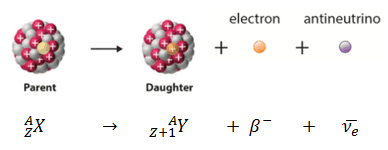

Beta particles free#
In their wake, they leave a trail of positive ions (atoms from which electrons have been removed) and free electrons. When ejected from a decaying nucleus, alpha particles interact with all matter in their path, whether it be photographic film, lead shielding, or body tissue, stripping electrons from other atoms as they go. Atoms that have acquired a charge by losing or gaining electrons are called ions.īesides He 2+, other symbols for this particle are The symbol O 2- means an oxygen atom that has added two electrons and thus has a charge of -2. Thus He 2+ means a helium atom that has lost two electrons and has a +2 charge. If a particle has a charge, whether negative or positive, it can be shown as a superscript. Because an alpha particle has no electrons to balance the positive charge of the two protons, it has a charge of +2 and can be represented as He 2+. Ionizing radiation, so called because their passage through matter leaves a trail of ions and molecular debris.Īn alpha particle is identical to a helium atom that has been stripped of its two electrons thus, an alpha particle contains two protons and two neutrons. We will discuss three of these emissions: alpha particles, beta particles, and gamma rays. Nuclei undergoing nuclear decay release various kinds of emissions.

Uranium has 14 known isotopes, all of which are radioactive.

Of these, only iodine-127 is stable this isotope is the only naturally occurring one. Iodine, an element widely used in nuclear medicine, has 24 known isotopes ranging in mass from 117 to 139 amu. Oxygen, the Earth's most abundant element, has 8 known isotopes, 5 of which are radioactive (oxygen-13, -14, -15, -19, and -20). Of the 3 known isotopes of hydrogen, one is radioactive - hydrogen-3, more commonly known as tritium. Every element, from atomic number 1 through number 109, has at least 1 natural or artificially produced radioactive isotope. Over a thousand radioactive isotopes have been produced in the laboratory. Of the 350 isotopes known to occur in nature, 67 are radioactive. A radioactive isotope is called a radioisotope. Often, one isotope of an element is radioactive and others of the same element are stable.

Others that are normally stable can be made radioactive by bombarding them with subatomic particles. In nuclear decay, the nuclei of radioactive atoms decay spontaneously to form other nuclei, a process that always results in a loss of energy and often involves the release of one or more small particles. Of nuclear decay, which is also called radioactivity or radioactive decay of We will describe properties of the nucleus and, in particular, the characteristics Of elements in detail in the next chapter. We will discuss electrons and the chemical properties In the atom, particularly those farthest from the nucleus, determine the chemical Neutrons, and the extranuclear space, which contains the electrons. From the discussions in the previous section, we know that the atoms of anyĮlement have two distinct parts: the nucleus, which contains the protons and


 0 kommentar(er)
0 kommentar(er)
